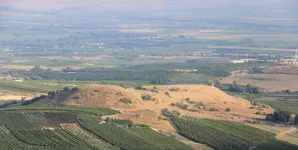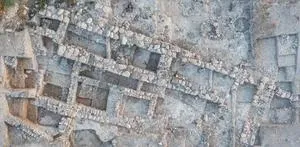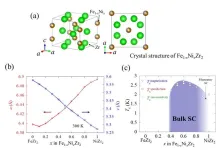(Press-News.org) Archaeologists have uncovered a rare Tetrarchic boundary stone at the site of Abel Beth Maacah in northern Israel. Originally marking land borders under Roman Emperor Diocletian’s tax reforms, the stone provides insight into ancient land ownership, local settlement patterns, and imperial administrative practices. The discovery also introduces two previously unknown place names, expanding our understanding of the region’s historical geography and socio-economic landscape.
Archaeologists Prof. Naama Yahalom-Mack and Dr. Nava Panitz-Cohen from the Institute of Archaeology at the Hebrew University, and Prof. Robert Mullins from Azusa Pacific University have uncovered a significant relic of ancient administrative practices during their excavation of the biblical site of Abel Beth Maacah near Metula in northern Israel. The find, which was deciphered by Dr. Avner Ecker and Prof. Uzi Leibner from the Hebrew University is a boundary stone, originally inscribed to delineate agrarian borders between villages during the reign of the Roman Tetrarchy (a short-lived system instituted by the emperor Diocletian in 293 CE to govern the Roman Empire by dividing it between two emperors, the augusti, and their junior colleagues and designated successors, the caesares) and was found in secondary use in a Mamluk-period installation. This basalt slab, etched with a detailed Greek inscription, has provided a wealth of historical insights.
The inscription revealed two previously unknown village names, Tirthas and Golgol, which may correspond to ancient sites identified in the 19th-century Survey of Western Palestine. The slab also mentions an imperial surveyor, or "censitor," whose name is attested here for the first time. These markers reflect the sweeping tax reforms initiated by Diocletian in the late third century CE, emphasizing the role of land ownership and settlement structures in the economic landscape of the Roman Near East.
“This discovery is a testament to the meticulous administrative re-organization of the Roman Empire during the Tetrarchy,” said Prof. Uzi Leibner. “Finding a boundary stone like this not only sheds light on ancient land ownership and taxation but also provides a tangible connection to the lives of individuals who navigated these complex systems nearly two millennia ago.”
Dr. Avner Ecker added, “What makes this find particularly exciting is the mention of two previously unknown place names and a new imperial surveyor. It underscores how even seemingly small discoveries can dramatically enhance our understanding of the socio-economic and geographic history of the region.”
This discovery adds to a unique corpus of over 20 boundary stones concentrated in the northern Hula Valley and surrounding areas. The stones mark a period of heightened administrative control aimed at standardizing taxation and clarifying land ownership. Remarkably, this specific find highlights the interconnectedness of historical geography, economic policies, and local settlement patterns. Scholars believe the abundance of boundary stones in this region underscores the high concentration of small landholders who operated independently of major urban centers. Interestingly, a contemporaneous rabbinic tradition mentions a burden imposed by the emperor Diocletian on this specific area, and apparently also reflects the hardships the tax reform drew on the local population.
The find enriches our understanding of the socio-economic dynamics during the Tetrarchy, particularly the implications of Diocletian’s reforms on rural communities. Prof. Leibner and Dr. Ecker emphasize that such discoveries provide a unique glimpse into the lives of ancient inhabitants, the pressures they faced under imperial rule, and the enduring traces of their communities in the archaeological record. This exceptional artifact now joins the broader narrative of Roman imperial administration in the Levant.
END
A new chapter in Roman administration: Insights from a late Roman inscription
2025-01-20
ELSE PRESS RELEASES FROM THIS DATE:
Global trust in science remains strong
2025-01-20
A global survey spanning 68 countries reveals that public trust in scientists is still high. Led by the University of Zurich and ETH Zurich, a team of 241 researchers conducted the largest post-pandemic study of trust in science, societal expectations and public views on research priorities.
Trust in scientists is at a moderately high level worldwide, according to a new study. This is the conclusion of an international team of 241 researchers led by Viktoria Cologna of ETH Zurich and Niels G. Mede of the University of Zurich (UZH). “Our results show that most people in most countries have a relatively ...
New global research reveals strong public trust in science
2025-01-20
A new international study on public trust in science, conducted across 68 countries, has found that most people trust scientists and believe they should be more involved in society and policymaking. Further, a majority of survey participants believe that scientists should be more involved in society and policymaking.
Published in Nature Human Behaviours (pre print link), this research was conducted by TISP, a Harvard University-based consortium led by Dr Viktoria Cologna (Harvard University, RTH Zurich) and Dr Niels G Mede (University of Zurich), which includes 241 researchers from 169 institutions worldwide, including the University of Bath.
The study, which includes 71,922 respondents—2,008 ...
Inflammation may explain stomach problems in psoriasis sufferers
2025-01-20
People with the skin condition psoriasis often have invisible inflammation in the small intestine with an increased propensity for ‘leaky gut’, according to new research at Uppsala University. These changes in the gut could explain why psoriasis sufferers often have gastrointestinal problems and are more prone to developing Crohn’s disease. The study is published in Biochimica et Biophysica Acta (BBA) – Molecular Basis of Disease.
Psoriasis is a hereditary, chronic skin condition that can also result in inflammation of the joints. In Sweden, almost 300,000 people live with some form of the condition. Chronic inflammatory bowel ...
Guidance on animal-borne infections in the Canadian Arctic
2025-01-20
A new review on zoonotic infections — diseases transmitted by animals — in the Canadian Arctic provides timely guidance to clinicians as the region experiences heightened global interest as well as climate change, which threatens the region and increases risk of disease transmission. The review, published in CMAJ (Canadian Medical Association Journal) https://www.cmaj.ca/lookup/doi/10.1503/cmaj.240541, provides guidance on how to identify and manage seven zoonotic infections in people.
“Indigenous Peoples continue to be caretakers of ...
Fatty muscles raise the risk of serious heart disease regardless of overall body weight
2025-01-20
People with pockets of fat hidden inside their muscles are at a higher risk of dying or being hospitalised from a heart attack or heart failure, regardless of their body mass index, according to research published in the European Heart Journal [1] today (Monday).
This ‘intermuscular’ fat is highly prized in beef steaks for cooking. However, little is known about this type of body fat in humans, and its impact on health. This is the first study to comprehensively investigate the effects of fatty muscles on heart disease.
The new finding adds evidence that existing measures, such as body mass index or waist ...
HKU ecologists uncover significant ecological impact of hybrid grouper release through religious practices
2025-01-19
Ecologists from the School of Biological Sciences (SBS) and the Swire Institute of Marine Science (SWIMS) at The University of Hong Kong (HKU) have identified significant ecological risks associated with the release of hybrid groupers into Hong Kong’s coastal waters, a practice often linked to religious ‘mercy release’ rituals.
Their study highlights how the Tiger Grouper-Giant Grouper hybrid (TGGG), also known as the Sabah grouper, disrupts local marine ecosystems by exploiting unique ecological niches and potentially becoming a dominant predator. This research, the first ...
New register opens to crown Champion Trees across the U.S.
2025-01-18
The National Champion Tree Program (NCTP) announced its first Register of Champion Trees since 2021. The program moved from American Forests to the University of Tennessee School of Natural Resources in 2023 and has spent the past year working with state-level Champion Tree programs across the U.S. to update outdated records and verify the newly crowned champions.
“We are thrilled beyond measure to share the list of the largest documented trees in the United States,” Jaq Payne, NCTP director, said. “These trees are more than just numbers on a website. They're living, breathing members of our community. I hope this register encourages folks to start ...
A unified approach to health data exchange
2025-01-18
About The Article: This article outlines the ways in which the U.S. Department of Health and Human Services has worked to use electronic health record data to improve patient health, public health, and health care.
Corresponding Author: To contact the corresponding author, Robert M. Califf, MD, email commissioner@fda.hhs.gov.
To access the embargoed study: Visit our For The Media website at this link https://media.jamanetwork.com/
(doi:10.1001/jama.2025.0068)
Editor’s ...
New superconductor with hallmark of unconventional superconductivity discovered
2025-01-18
Tokyo, Japan – Researchers from Tokyo Metropolitan University have discovered a new superconducting material. They combined iron, nickel, and zirconium, to create a new transition metal zirconide with different ratios of iron to nickel. While both iron zirconide and nickel zirconide are not superconducting, the newly prepared mixtures are, exhibiting a “dome-shaped” phase diagram typical of so-called “unconventional superconductors,” a promising avenue for developing high temperature superconducting materials which can be more widely deployed in society.
Superconductors already play ...
Global HIV study finds that cardiovascular risk models underestimate for key populations
2025-01-18
Cardiovascular disease (CVD) is the leading cause of morbidity and mortality globally, posing a particularly significant threat to people with HIV (PWH). To address this, CVD prevention plans rely on prediction models like atherosclerotic cardiovascular disease (ASCVD) risk scores to estimate the risk of heart disease.
However, previous studies have called into question whether these commonly used prediction models perform well among people with HIV, and there remains a gap in understanding of what these scores mean for PWH in low- and middle-income countries (LMICs).
Researchers from Massachusetts General Hospital, a founding member of the Mass General Brigham ...







